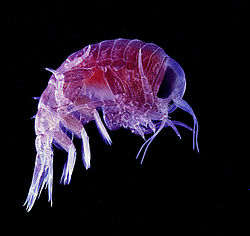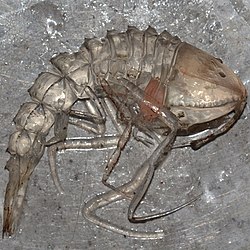- Specimen of Streetsia challengeri (Oxycephalidae)
- Specimen of Phronima sedentaria (Phronimidae)
- Specimen of Themisto (Hyperiidae)
- Specimen of Cystisoma (Cystisomatidae)
| Hyperiidea | |
|---|---|
 | |
| Hyperia (Hyperiidae) | |
| Scientific classification | |
| Kingdom: | Animalia |
| Phylum: | Arthropoda |
| Class: | Malacostraca |
| Order: | Amphipoda |
| Suborder: | Hyperiidea H. Milne-Edwards, 1830 |
| Families | |
See text | |
The Hyperiidea is one of the six suborders of amphipods, small aquatic crustaceans. Unlike some other suborders of Amphipoda, hyperiids are exclusively marine and do not occur in fresh water. Hyperiids are distinguished by their large eyes and planktonic habitat. Most species of hyperiids are parasites or predators of salps and jellyfish in the plankton, although Themisto gaudichaudii and a few relatives are free-swimming predators of copepods and other small planktonic animals.



